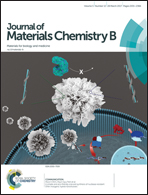Cell-inspired biointerfaces constructed from patterned smart hydrogels for immunoassays in whole blood†
Abstract
Immunoassays have shown great advances in the fields of biomedical diagnosis. However, successful immunoassays in blood plasma or whole blood based on the designed biointerfaces are still rare. Here, a newly cell-inspired biointerface for immunoassays in blood is demonstrated. Inspired by the high resistance to protein and cell adhesion and extraordinary biological recognition of stem cells, the biointerfaces are constructed by patterning smart hydrogels (PNIPAAm-co-PNaAc) on hydrophilic layers (PEG), followed by immobilization of antibodies on the patterned hydrogels. The hierarchical biointerfaces are hydrophilic to resist blood plasma and blood cell adhesion, but exhibit high affinity to the target antigens. As a result, successful immunoassays in blood are achieved. In addition, the detection signal is further enhanced by the manipulation of the phase transition of the smart hydrogels with temperature, and the sensitivity is higher than that of the widely-used poly(acrylic acid)/(polyacrylate) platform. The biointerface is versatile and effective in antibody–antigen recognition, which offers a potential new approach for developing highly sensitive immunoassays in blood.



 Please wait while we load your content...
Please wait while we load your content...